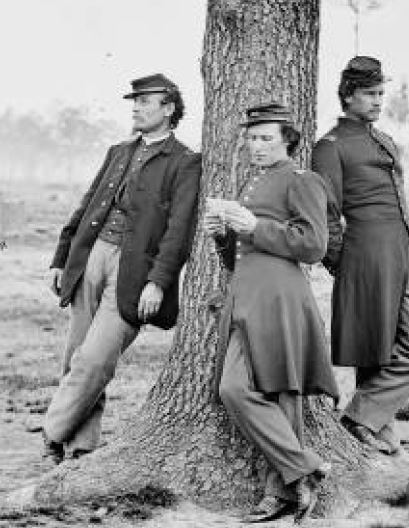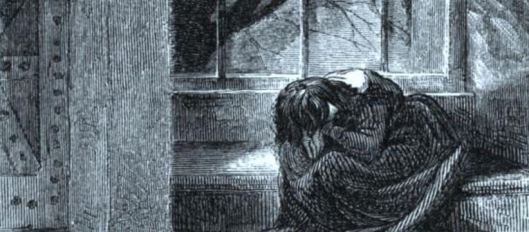“Good came out of evil, as it often does…” Thus writes Susan Warner at the end of her novel The Wide, Wide World, a work often considered America’s first best seller. It was certainly a literary sensation. Published by Putnam in 1851 Warner’s novel was widely acclaimed. Henry James, for example, compared it to the... Continue Reading →
New Year’s Eve Civil War Style
The turn of the year from old to new has long been celebrated in a variety of ways sometimes with frivolity and sometimes with spirituality, and sadly, sometimes on the battlefield. This is true of the Civil War period also. Celebrating with Frivolity According to Alexis McCrossen, writing for We’re History, men and women belonging... Continue Reading →
A Coat of Shoddy
I Wish I Had a Fat Contract to the tune of Barbara Allen But if I had a fat contract To make clothes for de solders De army coats and striped pants, I wouldn't use no shoddy Nor no oder stuff that's rotten; But I'd use the very best of cloth, Widout a bit of... Continue Reading →
Valentine’s Day Civil War Style
"...this is the day on which those charming little missives, ycelped* Valentines, cross and inter-cross at every street and turning. The weary and all forespent twopenny postman sinks below a load of delicate embarrassments, not his own." Valentine's Day in Essays of Elia by Charles Lamb 1860 (*called) Valentine's Day was a well-established holiday by the... Continue Reading →
Mailing a Letter Civil War Style
During wartime communicating with loved ones becomes an overwhelming concern. In the Civil War period many soldiers and families wrote letters to each other almost daily. Postage was cheap by our standards 3 cents per half ounce which was lowered to 2 cents in October of 1863. But for people who earned an average salary of $20 a month... Continue Reading →
The Christmas Tree Civil War Style
When we think of magic, probably one of the most magical things of the Christmas season are brilliantly lit Christmas trees. Although decking the house with boughs of pine was a traditional Christmas practice [the pine scent was believed to clean the air and prevent disease], Christmas trees were uncommon in early America. The custom,... Continue Reading →
Turkey Civil War Style
While soldiers in the field were waiting for their turkeys to arrive packed in crates filled with straw and kept cold, hopefully, by winter weather, at home women were preparing to roast their turkeys. Roasting a turkey in the 1800s meant cooking it on a spit inside a tin oven. Catherine Esther Beecher in her 1859... Continue Reading →
Henry Ward Beecher on Pumpkins
As much as the pumpkin is used as a term of ridicule, who ever saw a pumpkin that seemed to quail or look sheepish? Henry Ward BeecherHenry Ward Beecher (1813-1887) was minister of the Plymouth Congregational Church in Brooklyn. He is best known for his break with his father's hell and brimstone Calvinism to a belief in... Continue Reading →
A Civil War Boy’s Diary
In my last post I referred to the diary of Lucy James Stoughton of Castle Creek. I came across another local diary in my files. This one by a boy of about the same age as Lucy. Diary of a Binghamton Boy of the 1860s was edited and explained by Marjory Barnun Hinman and published in... Continue Reading →
Civil War Medical Books for the Home
"Medical works are generally a heterogeneous compound of vague ideas and jaw-breaking words, in which the dead languages are largely employed to treat of living subjects. Orthodoxy in medicine consists in walking in the beaten paths of Esculapian ancestors, and looking with grave contempt on all who essay to cut out new paths for themselves.... Continue Reading →
Beneficient Ladies of New York
If you were a well-to-do lady living in New York in April 1864 and a member of the Union League Club House, you might have found yourself deep in preparations for the Metropolitan Fair. Impressed by the successes of the Sanitary Fairs in Chicago and Boston in raising money for the care of wounded soldiers, New... Continue Reading →
Games for Girls from the 1862 American Girls’ Book
While the boys were outside building snow forts and giant men, the girls were inside putting on plays, playing games, or amusing themselves with paper and cardboard and cloth following the directions in the 1862 American Girl's Book by Miss Leslie, a volume intended as an "unpretending manual of light and exhilarating amusements; most of... Continue Reading →
Fun in the Snow 1860s Style
It snowed today and a white Christmas is predicted for my region. Time to have fun in the snow! Despite the war, children during the Civil War period loved snow as much as children do today. Indeed, the 1864 American Boy's Book of Sports and Games included snow play among its many healthful activities for American boys.... Continue Reading →
Sleigh Rides in the 1860s
Why do parties choose a moonlit night for sleigh rides? Because they are pleasanter than dark nights. "Proceedings of the Farmers' Club" in the Annual Report of the City of New York 1864 p. 165. Here it is December 15, and no snow, no snowmen, and no sleds. I am looking out my window... Continue Reading →
A Civil War Christmas Story
There are but few children, in this matter-of-fact age, who have real faith in the jolly little man with mouse-skins and reindeer... No this wasn't written in 2012. This is taken from the children's book Keep a Good Heart: A Story for Christmas Time by Cousin Carrie 1864 p. 78. What can children's books tell... Continue Reading →
Almanacs: Time, Tides, and Government Officials
Today November 11th I picked broccoli in my garden, an unheard of event in the time I have lived here on the Allegany Plateau of central New York. Usually by now successive nights in the 20s would have done even those hardy plants in. If I were to believe the Old Farmer's Almanac 2013, instead of... Continue Reading →
Friendly Advice for the Farmer
What about Civil War era farmers? Where did they get their knowledge of how to grow the crops that fed their families, villages, towns, cities, and armies? Why from the American Agriculturist published with the modern farmer in mind from 1845 to today. Here, found interspersed between melodramatic stories, children's drawings, and Rebus puzzles, amidst ads for... Continue Reading →



















